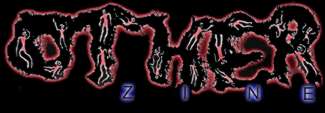
Scott Stark's "Angel Beach"
by Kerry Laitala
Click here for printable version.
Angel Beach
Scott Stark
16mm, 25 minutes, color, silent, 18
f.p.s. (2001)
3D glasses never quite fit on my face, but Scott Starkís newest film, "Angel Beach" needs no such apparatus for the viewer to experience the luxurious illusion of three-dimensional imagery. Wielding a 16mm Bolex, Stark has literally stretched a single moment in time into two moments by re-photographing successive frames of 3D slides. This painstaking process took over a year to perfect, and Stark succeeded in reassembling these images into a world that seethes with a sultry life of its own, yielding a quivering image that calls attention to our perceptual limitations by expanding the boundaries of the film plane and spatial realism. Actually, this pulsating effect creates a fissure between two and three dimensions allowing the viewer to slip inside this perceptible slice of time.
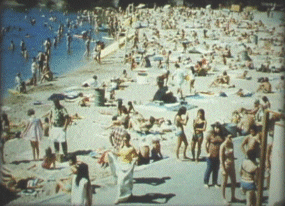 Coppertone
and even the darkest of sunglasses
cannot dispel the imprints of buxom,
bathing beauties that writhe and flicker
their ways across the sandscape, and
the imagined soundtrack of waves,
surf and seagulls punctuated by the
occasional peal of laughter paves
the way for a rapturous reverie.
Coppertone
and even the darkest of sunglasses
cannot dispel the imprints of buxom,
bathing beauties that writhe and flicker
their ways across the sandscape, and
the imagined soundtrack of waves,
surf and seagulls punctuated by the
occasional peal of laughter paves
the way for a rapturous reverie.
Angel Beach is an immortal place where youthful skin is exposed for the first time to the rays of the sun, and the gaze and desire of others. One feels the reminiscence of sand between the toes, and other crevices of the body recalling the sensual physicality of childhood when one returns home with half the beach in the bathing suit and hair. Angel Beach also revives a pubescent memory from my past of wearing a bright red bathing suit at the beach that became almost see through when wet, (and the subsequent remembrance of self-consciousness incited by the voyeurism of others). At Angel Beach, however, there is a feeling of empowerment as these sea nymphs are simultaneously active, but frozen in mid-action captured by the lens of the camera. Stark found these images circa 1969-71 at a flea market and they are artifacts of anonymous subjects and moments frozen in time. Like the remains of Pompeii, where sections of the city were unearthed with the bodies of people found in mid action without the gruesome horror of the moment of death, one still feels that these artifacts somehow reveal a sense of human frailty amidst their unabashed sensuality and ecstatic revelry. These surprising paradoxes present themselves as one thinks of the adage, "in the midst of life, we are in death".
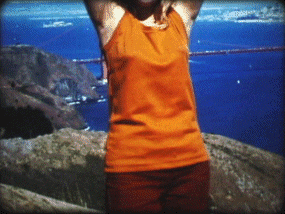 A
"Starkian" juxtaposition
can most classically be defined by
a gesture that has been culled; coaxed
from the original material, mediated
through the filmmaker to re-inscribe
or create new meanings from the composition,
movement, rhythm of the material.
The in-between expanse of film frames
come alive where hidden potentialities
are released to the consciousness
of a receptive viewer. Impossible
relationships between sultry physiques
collide and intersect in this world
where space is mutable, and whimsy
and folly are transcribed into the
most intricate entanglements. As a
slice of life unrestrained, frames
become animated in a flux of nimble
delight through the impossible intersections
of spaces and flesh, which intertwine
elliptically.
A
"Starkian" juxtaposition
can most classically be defined by
a gesture that has been culled; coaxed
from the original material, mediated
through the filmmaker to re-inscribe
or create new meanings from the composition,
movement, rhythm of the material.
The in-between expanse of film frames
come alive where hidden potentialities
are released to the consciousness
of a receptive viewer. Impossible
relationships between sultry physiques
collide and intersect in this world
where space is mutable, and whimsy
and folly are transcribed into the
most intricate entanglements. As a
slice of life unrestrained, frames
become animated in a flux of nimble
delight through the impossible intersections
of spaces and flesh, which intertwine
elliptically.
Figures are situated in many states of action and repose; their forms seem at times graceful, predatory, solitary, awkward, and whimsical sometimes bordering on the ridiculous. As people are placed together in a frame their eyes become enmeshed as different facial features, eyes, cheeks, skin tones become exchangeable and their similarities outweigh differences.
In one image we see a woman confronting the photographer, hands outstretched, fingers spread in an attempt to obfuscate, and prohibit her visage from being stolen. She directly engages with and displays her irritation against the cameraperson leaving the viewer with the contemplation of scenarios of what might have happened next in this world of suspended instants of time. Her angry reaction revoked the privilege of subsequent viewings, shattering the illusion of the original photographerís omnipotence.
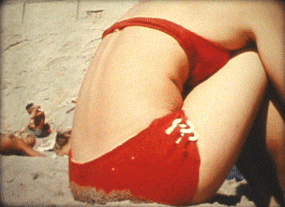 In
1970, while the anonymous photographer
of "Angel Beach" was scouring
California beaches in search of material,
the Mitchell Brotherís released their
landmark porn film "Behind the
Green Door", which featured a
seemingly endless come shot, the gesture
of ecstacy extending ad infinitum,
similar to a scientific analysis of
motion by Harold Edgarton. However
in Stark's film we are witness to
a staccato tango between both parties
engaged in equal participation. In
Angel Beach, through the intervention
of Starkís re-photography, the woman
is active instead of reclining in
languid complicity, and any projectile
fluids are in the imagination of the
viewer. A more literal association
would be a wild reverie of cheap beer
and sex, which is more in keeping
with the Schlitz can being shaken
by the movements of the man's suntanned
hand and sensuous gestures of the
woman who appears to be rubbing her
smoldering body. Stark choreographs
these forms to quaking perfection.
In
1970, while the anonymous photographer
of "Angel Beach" was scouring
California beaches in search of material,
the Mitchell Brotherís released their
landmark porn film "Behind the
Green Door", which featured a
seemingly endless come shot, the gesture
of ecstacy extending ad infinitum,
similar to a scientific analysis of
motion by Harold Edgarton. However
in Stark's film we are witness to
a staccato tango between both parties
engaged in equal participation. In
Angel Beach, through the intervention
of Starkís re-photography, the woman
is active instead of reclining in
languid complicity, and any projectile
fluids are in the imagination of the
viewer. A more literal association
would be a wild reverie of cheap beer
and sex, which is more in keeping
with the Schlitz can being shaken
by the movements of the man's suntanned
hand and sensuous gestures of the
woman who appears to be rubbing her
smoldering body. Stark choreographs
these forms to quaking perfection.
In Angel Beach the audience becomes privy to secret longings of the image makers, as the presence of the outsider is supremely felt; one who would perhaps want to join, but can only observe. Thus the nymphets; initiates of the frolics in the sun are free to roam, while the observer is left in static longing behind the invisible wall of his camera. In one instance one sees a shadow that could be of the original camera person in the lower left corner of the frame, but one can never be certain. This shadowy presence is overlaid onto some of the human forms, and leaves one with the impression of a lurker whose identity will never be divulged to the audience, and we can never know the relationship or lack thereof with his oftentimes unsuspecting subjects. Angel Beach lends itself to myriad musings of these sometimes-enigmatic fragments.
Several fades segment the film into discreet sections that allow the viewer to take a pause to reflect on this world within a world that shivers its snaky path toward the viewer's retina as well as letting them rest from the visual sweltering onslaught.
About midway through the film the viewer is presented with a white bathing suit clad woman who is walking away from the camera. The image follows an in-camera fade as the form descends a staircase. The camera renders this human form very differently; she is seen ghostly white, overexposed and in high contrast to all other images in the film due to the cameraís flash. The seaweed-like trees on the left side of the frame offer a very different texture from the hot sand and wet skin. She is like an angel herself leading this beach of souls into the dark forest, a metaphor perhaps for the unknown realms that lie beyond the earthly domain. So radically different from the other imagery, this pivotal index of transcendence marks a departure embedded in a carousal of bodily forms.
Near the end of the film the unfinished phrase "A city is to man as a" can be seen, cryptically written on a sea wall. This urban trace locates the beach on the outskirts of the city, situating this mythological seascape on the edge of a concrete jungle, an escape from the anxieties of city life, but also into a landscape of ambiguity.
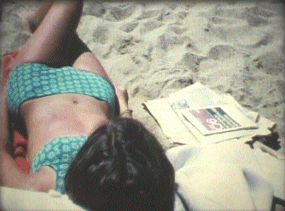 Some
would be disturbed by the voyeurism
present in Angel Beach, and Stark
makes no attempt to sublimate this
aspect. His foregrounding of this
element in the film reveals our own
inescapable complicity in looking
wide-eyed, unblinking. It would be
a vast reduction to say that the fragmentation
of the women's body is the only thing
happening here. Through the intervention
of the camera, the expansive terrain
of "Angel Beach" is opened
up, its forms dancing on the edge
of the film's precipice, to incite
a prismatic contemplation of the human
condition.
Some
would be disturbed by the voyeurism
present in Angel Beach, and Stark
makes no attempt to sublimate this
aspect. His foregrounding of this
element in the film reveals our own
inescapable complicity in looking
wide-eyed, unblinking. It would be
a vast reduction to say that the fragmentation
of the women's body is the only thing
happening here. Through the intervention
of the camera, the expansive terrain
of "Angel Beach" is opened
up, its forms dancing on the edge
of the film's precipice, to incite
a prismatic contemplation of the human
condition.
By Kerry Laitala,
San Francisco November 2001